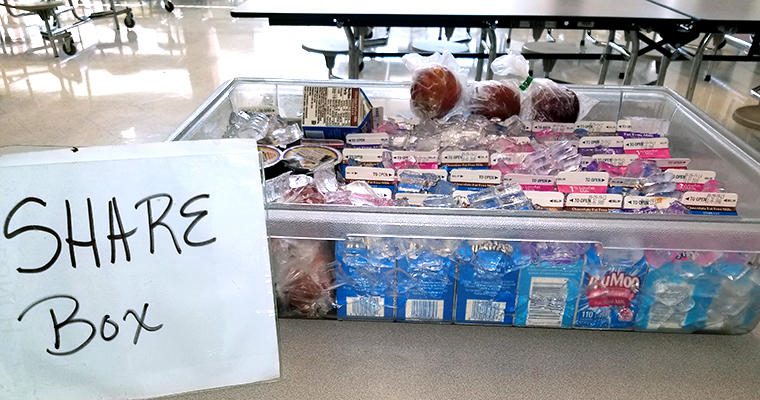School foodservice directors see hunger problems daily. Kentucky’s Hardin County Schools are taking a novel approach to fighting hunger and food insecurity with two programs that feed students and families in need.
The district’s Food Share Program sends leftover food home so families get nutritious meals on nights or weekends. School cafeterias identify useful leftovers, bag them, put them in meal boxes, then store for pickup. The cafeterias also have Sharing Tables where students can place unwanted wrapped foods for anyone to take and eat at lunchtime.
These two programs are overseen by Hardin’s Child Nutrition Director Josey Crew. For the take-home meals, she works with the 15,000-student district’s Family Resource Center to identify food insecurity among families and students.
The food packages are made available for confidential collection twice a week. Food boxes are typically picked up on Tuesdays and Fridays, Crew says. She points out that weekends are a critical time. “It’s hard to think of kids going home over the weekend and not having much to eat. You don’t know if they’re getting a proper meal until they come back to school on Monday.”
Tackling food-safety fears
Crew gives credit for starting the Food Share Program to Superintendent Terrie Morgan. She’s in charge of 13 elementaries, five middle schools and three high schools about 45 minutes south of Louisville in Elizabethtown, Kentucky.
“I was a little scared at first, just because of the liability. What happens if someone gets sick—I have to think about those things in my role,” Crew recalls. “But I also thought about all of those families we could really help and Mrs. Morgan just knew it was the right thing to do.”
Each participating family must sign a liability waiver, because the school cannot be responsible for how the food is handled, stored or reheated once it leaves the building. “We know it’s safe when it’s at the school; it’s up to you to make sure it’s safe at home,” Crews says.
Serving many families
The entire school system is part of the program’s success. Teachers, principals and staffers are in contact with students every day and learn to recognize hunger needs. They suggest families who might need help with food.
Currently, there are as many as 75 families who receive food, and Crews expects that number to grow during the school year.
Lunchroom sharing tables
The Sharing Tables are available in each school. Once students take foods required for a reimbursable meal, they can place items they don’t want in an ice-chilled container, which is monitored by a foodservice worker. The cafeterias wrap foods like apples and grapes on the serving line to ensure food safety when they’re put on the tables.
“Any student can take food from the table. It’s not restricted to students in need,” Crews says. “If a student brought a lunch from home and is still hungry, they are welcome to choose from the share cart.”
Savings, costs and satisfaction
The tables and food sharing are not just ways to feed hungry students, they also prevent food waste. After starting the Food Share Program and utilizing leftovers better, Crews saw food cost savings up almost $100,000 at the district’s largest high school in the first six months. Although she stopped tracking data, she estimates savings of more than $175,000 at the one school.
No extra staffing or equipment were needed to start the food sharing programs, Crew says, and cardboard boxes for packaging meals are plentiful at her schools. Her biggest noticeable cost was for plastic bags. “We’re always in need of food-safe bags—we go through a lot of bags, so that’s an ongoing cost.”
The rewards, Crews says, are worth the effort. A mother with a large family came in to express her gratitude. “Just thinking about her thanking us over and over for meals to get them through the weekend, it was very touching.”




























